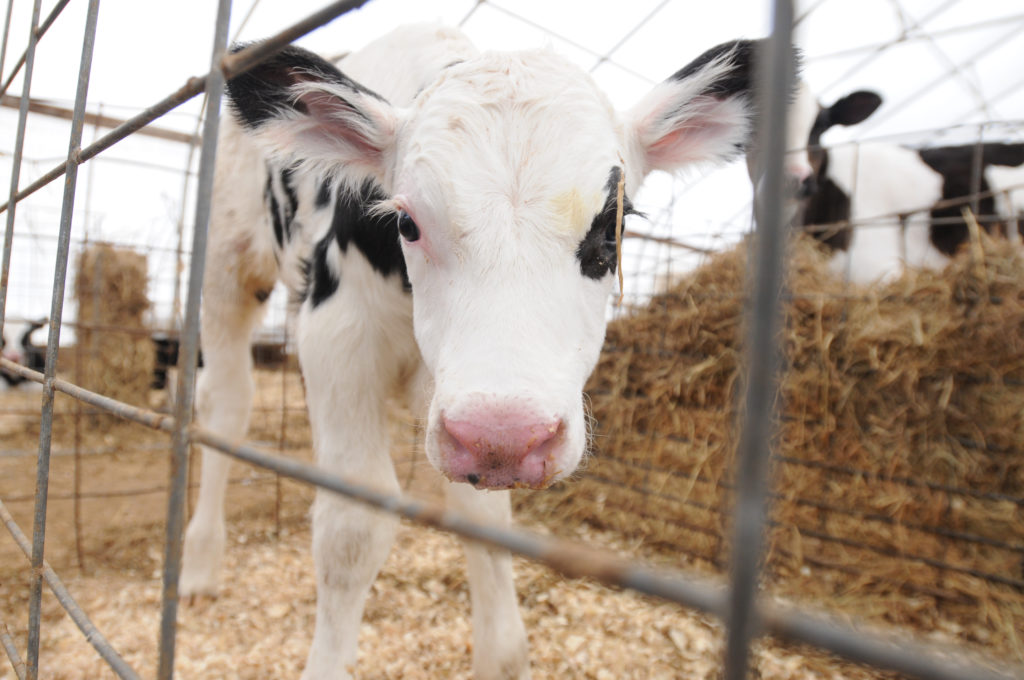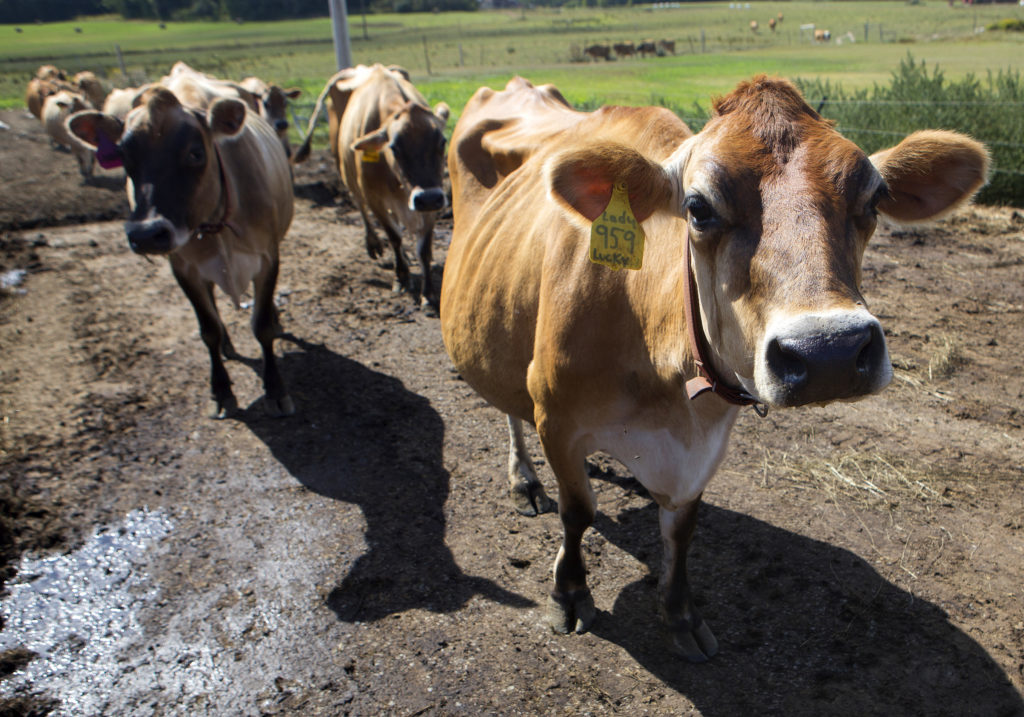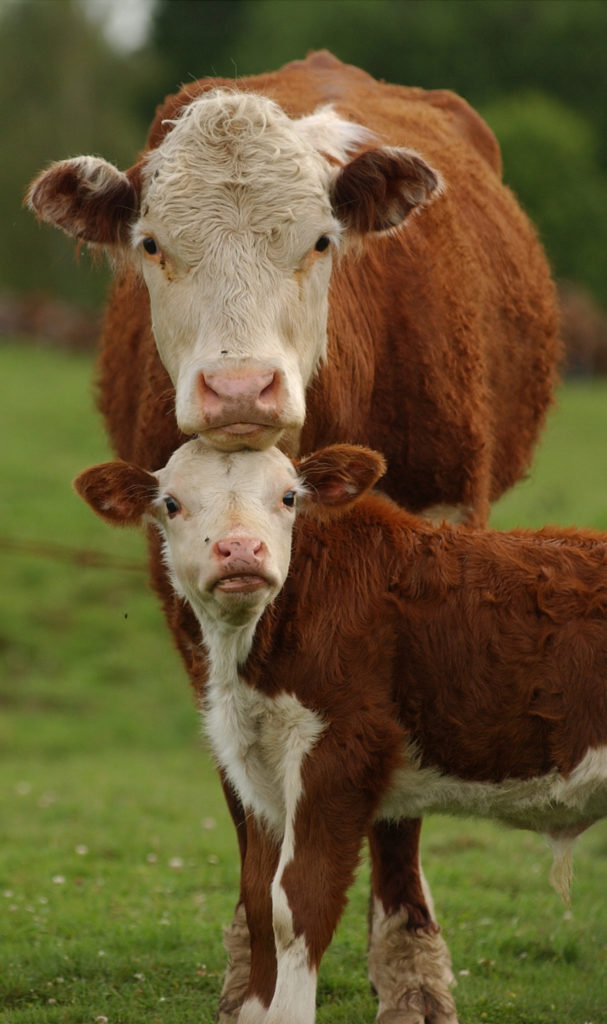12 things to know about raising cows

For many small farmers and homesteaders, cows are the white (or, perhaps, black and white) whale of livestock: always top of mind, but seemingly forever out of reach.
Most cows are physically bigger than other livestock, so they require more space and infrastructure than other ruminant animals like sheep and goats. Even mini cows are a bigger financial investment when it comes to upfront cost and maintenance.
If you simply cannot live any longer without homegrown beef and fresh milk, though, you may feel ready to dive in to raising cows. Before you decide to add cows to your litany of livestock, here are 12 things you need to know.
1. Cows can be raised for meat, milk and to produce offspring for sale. Know what you are going to use yours for before you purchase one.
A cow is a large investment in money, time and resources. Knowing how you plan to use your cow on your farm or homestead is important to make sure you are utilizing that investment wisely.
“The number one thing that people will want to ask themselves is why are we raising this cow,” said Colt Knight, state livestock specialist at the University of Maine Cooperative Extension. “It makes a huge difference in the type of land and infrastructure you need.”
Cows can be raised for meat and milk, either for personal use or for sale. Calves can also be sold each year for additional cash flow.
“They need to decide what their goal is going to be,” said Ashley Robbins, livestock and field crops agent for Chatham County at the North Carolina Cooperative Extension.
2. On a small scale, raising cows for milk only can be costly.
Cows begin producing milk at about two years old when they typically have their first baby. After the cow gives its first milk, or colostrum, to the calf, she will be ready to milk.
“They do have to have a baby in order to produce milk,” Robbins said. “As long as you milk them, they’ll produce milk. You can milk [a cow] for two years before she’s dried up without having another baby.”
Selling milk, however, can be difficult because of the rules and regulations governing dairy production.
“A small-scale dairy is not profitable at all,” Knight emphasized.
Some states — 13 in total, including Maine, California and Pennsylvania — allow the sale of raw milk in retail stores, while 17 others allow for raw milk-producing farms to sell the product on their premises. Eight states allow the sale of raw milk only through “cowshare agreements,” where cow owners farmers are paid to board, feed and milk their cows.
However, it is still illegal to sell raw, unpasteurized milk straight from the cow in 20 states, including Alabama, Colorado and Virginia.
“In North Carolina, you can’t sell raw milk, so that’s not feasible,” Robbins said. “The milk would probably just be for your personal use.”
If you plan to use your cow for personal milking and do not plan to eventually slaughter it, just know that you will likely be spending more money than you save.
“A cow is going to give you way more milk than you can consume,” Robbins said. “You wouldn’t have to buy any more milk, but that’s only $3 a gallon, so if you’re only buying two gallons of milk a month, you’re not saving money.”
Robbins said you could get creative to make money or save additional dollars on your grocery budget from your dairy cow.
“If you were to raise that calf that she’s feeding and sell it, you’d be able to make money on that,” Robbins said. “You could also turn the milk into butter and cheese, and cut out having to buy butter and milk and cheese.”
3. If you are raising cows for beef, know where you will process your meat.
Many farmers and homesteaders purchase a cow to raise for fresh, homegrown beef. Butchering cows, however, is complicated and requires a specific skill set and tools, so it is important to know where you will process your beef.
If you are raising a cow for beef, Robbins said that grass-fed cows will be ready to eat at around 28 to 30 months, while grain-fed cows can be ready by 15 to 16 months.
“If you just want to keep an animal for yourself in a freezer, buy stocker or a heifer [that’s between] 600 and 700 pounds,” Knight said. “It will put weight on through the summer, and come fall, you can take that animal to the meat processor and they’ll cut it up for you.”
Knight explained that if you plan on keeping meat for your own consumption, you can use a custom slaughter facility, but if you are hoping to sell some meat, the facility must be state or federally inspected depending on whether you plan to sell in-state or across the border.
Even if you are not going to sell the meat, you need to know who is going to process your animal. It may be challenging to find a qualified processor depending on where you live.
“We have very few meat processors in the state of Maine, so facilities fill up quickly,” Knight said. “Homesteaders will buy a calf in the springtime, it will get big enough to slaughter in the fall and the slaughterhouses are all booked up through the season. It’s a good idea to call your local processor and schedule time slot.”
Not only can forgetting to schedule time with a processor be disappointing, it can be costly, as you are left to feed your animal through the wintertime until you can get a spot at the slaughterhouse. This is especially challenging in colder climates.
“That’s the number one expense here in Maine,” Knight said. “With beef cows, you have to store a lot of hay through the wintertime.”
To find a reputable slaughterhouse, search the United States Department of Agriculture’s Food Safety and Inspection Service online directory of federally inspected slaughterhouses.
4. If you plan to sell your beef, research your markets and know where you will sell.
Knight and Robbins agreed that it is possible to make money selling homegrown beef. Though there are laws about properly labeling and safely processing meat to be sold, experts agree that they are easier to navigate than those for dairy. Plus, fresh meat is generally more profitable than milk.
“You could raise those on a small scale and breakeven or make some money,” Knight said. “You would provide yourself with meat, keep half and sell other half and profit off that.”
Just like when you are growing and selling crops, you want to know where you will sell your product before you invest time, energy and money into it.
“If you’re going to try to make money, you need to know who and where the market will be,” Robbins said. “If you can get into a market where people pay higher for a locally-grown, grass-fed beef, you can do pretty [well] just having a handful of cows, [like] if you’re close to a bigger town where you can hit the farmers market. Just one cow will give you 7 or 8 hundred pounds of beef at $6 to $8 a pound”

5. The best cow breed for you will mostly depend on where you live.
Robbins said that, in part, climate will determine which cows will thrive on your farm or homestead.
“Always something to consider what your environment is and if it’s suitable for certain breeds,” Robbins said. “Different cow breeds perform well in different areas.”
Robbins said if you are in a hot climate like Texas or Florida, you may want to avoid furry Highland cows, but sleek, heat-tolerant Brahman cows will thrive. Even within breeds, you can make certain choices to ensure your cows are as comfortable in their new home as possible.
“Angus do well [in North Carolina], but red better than black because of the heat,” Robbins said.
The economic forces in your area — for example, the cost of feed — may also impact the breed that you choose.
“Feed costs a lot [in Maine],” Knight said. “What we want here is a smaller frame animal so they don’t eat as much.”
In areas where feed is expensive, Knight recommended small Angus breed or British breeds like Hereford, or Belted Galloway (though, he admitted, Belted Galloways may have more value as show animals, because “they look like Oreos”).
Knight said to avoid continental breeds and larger frame breeds like Charolais, though they are well-suited farms in the Midwest, where easy geographical access to grain feed leads to lower prices. Some strains of a particular breed also may be slightly better for milk or meat, but generally you can find a cow that matches your goals regardless of which breed you choose.
“The genetic variation within a single breed is very large,” Knight said. “Over time, we have isolated really good genetics in all the different breeds, so you can get very good performing cattle in almost any kind of breed.”
6. The cost of a cow will depend on the breed, but you definitely want to purchase from a reputable seller.
The price of the cow will depend on the breed.
“If you’re going after a commercial cow, it will cost around $1,000,” Robbins said. “If you’re going after a certain breed, it could be $1,500 to $3,000 depending on what you’re trying to go after.”
No matter what breed you choose, make sure you are getting your cow from a reputable source.
“The best place to purchase a cow is from a quality breeder or a farmer that keeps good records,” Knight said.
“I would say the best bet would be from a personal buyer,” Robbins added.
Knight and Robbins agreed that it is best to avoid buying blind or purchasing cows from an auction or sale barn, even though the prices may be lower.
“You can buy cattle at auctions or off Facebook, but generally speaking, cattle that are at auction are generally there for a reason,” Knight explained. “They may not be producing that well. At auction, they’re exposed to a whole bunch of different animals may have a higher incidence of sickness.”
Robbins said that the exception is if the sale is a registered sale, where they will provide important information about the animal, like vaccination history and past pregnancies.
“I would do my research and know where my cows are coming from,” Robbins said. “I would not just buy a cow blindly.”
7. It is important to know a large animal veterinarian that can care for your cow when it is sick.
When you are purchasing your cow, be sure to also ask around for a veterinarian.
“Animal health is very important,” Knight said. “You want to make sure they’re growing properly. Just like dogs and cats need annual vaccines, cows need vaccines. Depending on your area, they might need a rabies shot.”
Knight and Robbins both recommended asking the seller of the cow who their veterinarian is, but there are other ways you can find one.
“Nowadays, a lot of it is online,” Robbins said. “If you have a small animal vet, maybe they know a large animal vet. Your cooperative extension should also have a list of veterinarians that you could work with.”
8. For cows, the quality of your land matters just as much as the quantity.
Cows require a considerable amount of space when compared to other livestock.
“You want at least an acre per cow,” Robbins said. “If they’re going to have a baby, you want two acres for a cow-calf pair. That’s the minimum amount of land.”
For cows, the quality of the land — specifically, the foraging material on it — matters just as much as the amount of land.
“Take a soil sample of the pasture and get an analysis,” Robbins said. “That’ll tell you what type of fertilizer or lime you need to put out in order to grow good quality forage. That’s key when raising cows if you want to be able to graze them.”
If your forage quality is low, you may need to provide your cows with more land or two supplement their diet.
“If it’s poor quality forage, you might need 5 or 10 acres for that same cow,” Knight said. “If you don’t have the acreage or the forage quality you need to supplement their diet with some grain. I wish there was a one size fits all answer to that, but unfortunately, you have to know what you have.”
Maintaining the pasture is also an essential part to raising cows.
“It’s better to have multiple pastures, or at least break up pasture,” Robbins said. “You don’t want to continuously graze a certain area because that’s too much pressure on the grass and it won’t grow back.”
9. Most cows need mineral supplements to stay healthy.
Quality forage will provide cows with the nutrients that they need.
“If you’re solely doing grass-fed, it’s a good idea to have a high quality forage out there at all times and have a legume in with your normal grass,” Robbins said.
Robbins explained legumes like cow peas and crimson clover are good in the summer, and cold season legumes like hairy vetch will supplement pasture-fed cows in the winter.
Even if you plan to grass-feed your cows, use a soil test make sure your forage is providing them with all the minerals they need.
“If your ground is low in selenium, sulfur or zinc, you may be able to balance the minerals for your area,” Knight said. “The feed store would know that.”
If you are feeding your cow hay, you may need to get a nutrient analysis of your hay.
“All hay is different,” Robbins said. “Once you get your results back, you can chart it with the minimum nutrient requirements.”
Knight said that many cow owners forget to supplement their animals’ minerals. The required supplement depends on what you feed them and where you are located.
“If you want to do grain, then you need some kind of high-protein corn,” Knight explained. “Feed stores also have bags of minerals depending on where you’re located.”
10. Fencing and housing is essential for cows.
Cows also require some infrastructure — namely, fencing around the pasture to keep them on your property.
“You need to have good permanent fencing around pasture so you can keep in the cows,” Robbins said.
“Cows are big animals so they can knock over an ill-constructed fence very easily,” Knight added.
Though cows are fairly hardy, they also need shelter to occasionally escape the elements.
“The structure needs to have good ventilation,” Knight said. “They don’t have to have an insulated barn, but they do need a clean, dry place to lay in the winter time.”

11. Cows need fresh water
Even though they are grazing animals, cows need a steady supply of fresh water.
“Always make sure that they have access to fresh water,” Robbins said. “A lot of people just they can have them drink out of the ponds or streams, but that’s not good for the environment and that’s not fresh water, so it does affect them.”
12. To learn even more things about raising cattle, it might be helpful to take a class with your local cooperative extension.
Knight recommended that farmers and homesteaders looking to raise cattle should participate in some kind of beef quality assurance training. Knight runs a course through the University of Maine Cooperative Extension, and other extension branches may have similar courses.
“It is a good way for beginners to learn all the basics of cattle husbandry and record keeping Also, it has a low stress handling component associated with it,” Knight explained. “That’s a great opportunity to go over what cattle need and what to expect when raising cattle. ”
Even a basic level of rudimentary education about cattle husbandry will help you to better ensure animals on your farm are homestead are as healthy and happy as they can be.
